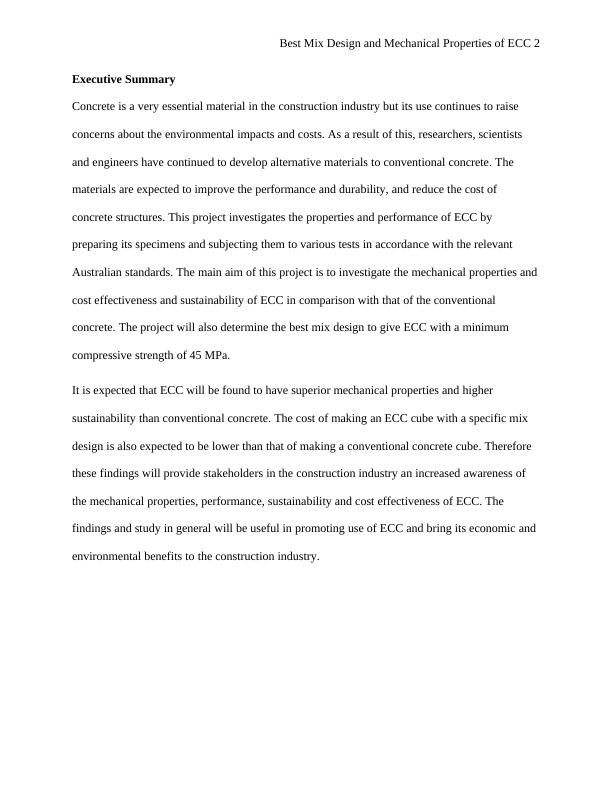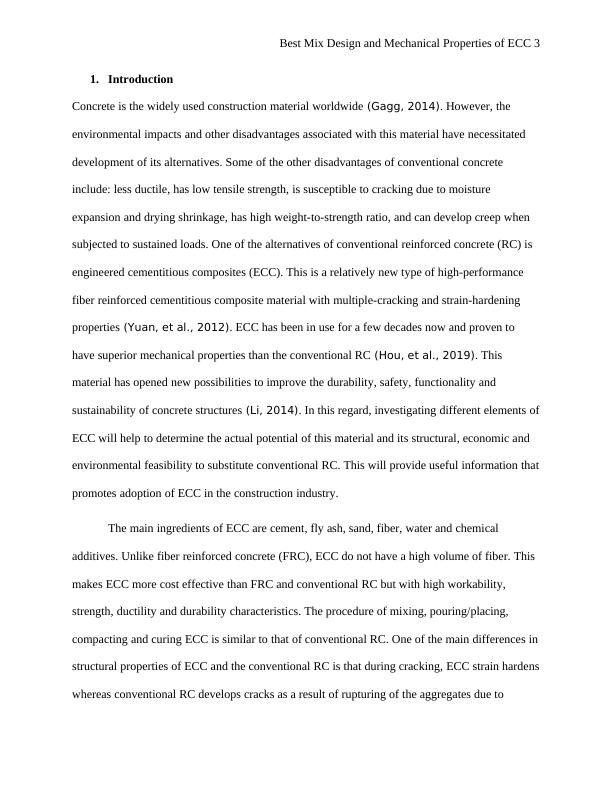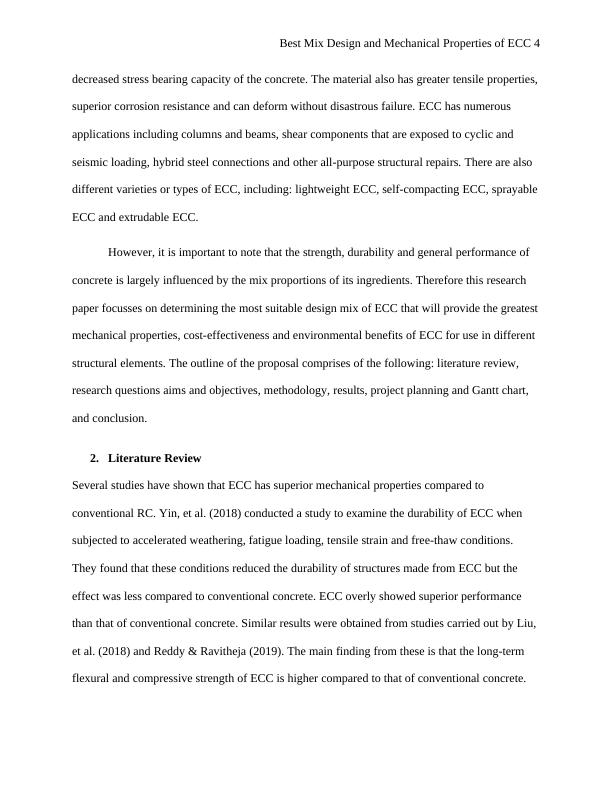Best Mix Design and Mechanical Properties of ECC 16
Added on 2023-01-19
16 Pages4459 Words81 Views
Best Mix Design and Mechanical Properties of ECC 1
INVESTIGATION OF SUITABLE MIX DESIGN AND MECHANICAL PROPERTIES OF
ECC
Name
Course
Professor
University
City/state
Date
INVESTIGATION OF SUITABLE MIX DESIGN AND MECHANICAL PROPERTIES OF
ECC
Name
Course
Professor
University
City/state
Date

Best Mix Design and Mechanical Properties of ECC 2
Executive Summary
Concrete is a very essential material in the construction industry but its use continues to raise
concerns about the environmental impacts and costs. As a result of this, researchers, scientists
and engineers have continued to develop alternative materials to conventional concrete. The
materials are expected to improve the performance and durability, and reduce the cost of
concrete structures. This project investigates the properties and performance of ECC by
preparing its specimens and subjecting them to various tests in accordance with the relevant
Australian standards. The main aim of this project is to investigate the mechanical properties and
cost effectiveness and sustainability of ECC in comparison with that of the conventional
concrete. The project will also determine the best mix design to give ECC with a minimum
compressive strength of 45 MPa.
It is expected that ECC will be found to have superior mechanical properties and higher
sustainability than conventional concrete. The cost of making an ECC cube with a specific mix
design is also expected to be lower than that of making a conventional concrete cube. Therefore
these findings will provide stakeholders in the construction industry an increased awareness of
the mechanical properties, performance, sustainability and cost effectiveness of ECC. The
findings and study in general will be useful in promoting use of ECC and bring its economic and
environmental benefits to the construction industry.
Executive Summary
Concrete is a very essential material in the construction industry but its use continues to raise
concerns about the environmental impacts and costs. As a result of this, researchers, scientists
and engineers have continued to develop alternative materials to conventional concrete. The
materials are expected to improve the performance and durability, and reduce the cost of
concrete structures. This project investigates the properties and performance of ECC by
preparing its specimens and subjecting them to various tests in accordance with the relevant
Australian standards. The main aim of this project is to investigate the mechanical properties and
cost effectiveness and sustainability of ECC in comparison with that of the conventional
concrete. The project will also determine the best mix design to give ECC with a minimum
compressive strength of 45 MPa.
It is expected that ECC will be found to have superior mechanical properties and higher
sustainability than conventional concrete. The cost of making an ECC cube with a specific mix
design is also expected to be lower than that of making a conventional concrete cube. Therefore
these findings will provide stakeholders in the construction industry an increased awareness of
the mechanical properties, performance, sustainability and cost effectiveness of ECC. The
findings and study in general will be useful in promoting use of ECC and bring its economic and
environmental benefits to the construction industry.

Best Mix Design and Mechanical Properties of ECC 3
1. Introduction
Concrete is the widely used construction material worldwide (Gagg, 2014). However, the
environmental impacts and other disadvantages associated with this material have necessitated
development of its alternatives. Some of the other disadvantages of conventional concrete
include: less ductile, has low tensile strength, is susceptible to cracking due to moisture
expansion and drying shrinkage, has high weight-to-strength ratio, and can develop creep when
subjected to sustained loads. One of the alternatives of conventional reinforced concrete (RC) is
engineered cementitious composites (ECC). This is a relatively new type of high-performance
fiber reinforced cementitious composite material with multiple-cracking and strain-hardening
properties (Yuan, et al., 2012). ECC has been in use for a few decades now and proven to
have superior mechanical properties than the conventional RC (Hou, et al., 2019). This
material has opened new possibilities to improve the durability, safety, functionality and
sustainability of concrete structures (Li, 2014). In this regard, investigating different elements of
ECC will help to determine the actual potential of this material and its structural, economic and
environmental feasibility to substitute conventional RC. This will provide useful information that
promotes adoption of ECC in the construction industry.
The main ingredients of ECC are cement, fly ash, sand, fiber, water and chemical
additives. Unlike fiber reinforced concrete (FRC), ECC do not have a high volume of fiber. This
makes ECC more cost effective than FRC and conventional RC but with high workability,
strength, ductility and durability characteristics. The procedure of mixing, pouring/placing,
compacting and curing ECC is similar to that of conventional RC. One of the main differences in
structural properties of ECC and the conventional RC is that during cracking, ECC strain hardens
whereas conventional RC develops cracks as a result of rupturing of the aggregates due to
1. Introduction
Concrete is the widely used construction material worldwide (Gagg, 2014). However, the
environmental impacts and other disadvantages associated with this material have necessitated
development of its alternatives. Some of the other disadvantages of conventional concrete
include: less ductile, has low tensile strength, is susceptible to cracking due to moisture
expansion and drying shrinkage, has high weight-to-strength ratio, and can develop creep when
subjected to sustained loads. One of the alternatives of conventional reinforced concrete (RC) is
engineered cementitious composites (ECC). This is a relatively new type of high-performance
fiber reinforced cementitious composite material with multiple-cracking and strain-hardening
properties (Yuan, et al., 2012). ECC has been in use for a few decades now and proven to
have superior mechanical properties than the conventional RC (Hou, et al., 2019). This
material has opened new possibilities to improve the durability, safety, functionality and
sustainability of concrete structures (Li, 2014). In this regard, investigating different elements of
ECC will help to determine the actual potential of this material and its structural, economic and
environmental feasibility to substitute conventional RC. This will provide useful information that
promotes adoption of ECC in the construction industry.
The main ingredients of ECC are cement, fly ash, sand, fiber, water and chemical
additives. Unlike fiber reinforced concrete (FRC), ECC do not have a high volume of fiber. This
makes ECC more cost effective than FRC and conventional RC but with high workability,
strength, ductility and durability characteristics. The procedure of mixing, pouring/placing,
compacting and curing ECC is similar to that of conventional RC. One of the main differences in
structural properties of ECC and the conventional RC is that during cracking, ECC strain hardens
whereas conventional RC develops cracks as a result of rupturing of the aggregates due to

Best Mix Design and Mechanical Properties of ECC 4
decreased stress bearing capacity of the concrete. The material also has greater tensile properties,
superior corrosion resistance and can deform without disastrous failure. ECC has numerous
applications including columns and beams, shear components that are exposed to cyclic and
seismic loading, hybrid steel connections and other all-purpose structural repairs. There are also
different varieties or types of ECC, including: lightweight ECC, self-compacting ECC, sprayable
ECC and extrudable ECC.
However, it is important to note that the strength, durability and general performance of
concrete is largely influenced by the mix proportions of its ingredients. Therefore this research
paper focusses on determining the most suitable design mix of ECC that will provide the greatest
mechanical properties, cost-effectiveness and environmental benefits of ECC for use in different
structural elements. The outline of the proposal comprises of the following: literature review,
research questions aims and objectives, methodology, results, project planning and Gantt chart,
and conclusion.
2. Literature Review
Several studies have shown that ECC has superior mechanical properties compared to
conventional RC. Yin, et al. (2018) conducted a study to examine the durability of ECC when
subjected to accelerated weathering, fatigue loading, tensile strain and free-thaw conditions.
They found that these conditions reduced the durability of structures made from ECC but the
effect was less compared to conventional concrete. ECC overly showed superior performance
than that of conventional concrete. Similar results were obtained from studies carried out by Liu,
et al. (2018) and Reddy & Ravitheja (2019). The main finding from these is that the long-term
flexural and compressive strength of ECC is higher compared to that of conventional concrete.
decreased stress bearing capacity of the concrete. The material also has greater tensile properties,
superior corrosion resistance and can deform without disastrous failure. ECC has numerous
applications including columns and beams, shear components that are exposed to cyclic and
seismic loading, hybrid steel connections and other all-purpose structural repairs. There are also
different varieties or types of ECC, including: lightweight ECC, self-compacting ECC, sprayable
ECC and extrudable ECC.
However, it is important to note that the strength, durability and general performance of
concrete is largely influenced by the mix proportions of its ingredients. Therefore this research
paper focusses on determining the most suitable design mix of ECC that will provide the greatest
mechanical properties, cost-effectiveness and environmental benefits of ECC for use in different
structural elements. The outline of the proposal comprises of the following: literature review,
research questions aims and objectives, methodology, results, project planning and Gantt chart,
and conclusion.
2. Literature Review
Several studies have shown that ECC has superior mechanical properties compared to
conventional RC. Yin, et al. (2018) conducted a study to examine the durability of ECC when
subjected to accelerated weathering, fatigue loading, tensile strain and free-thaw conditions.
They found that these conditions reduced the durability of structures made from ECC but the
effect was less compared to conventional concrete. ECC overly showed superior performance
than that of conventional concrete. Similar results were obtained from studies carried out by Liu,
et al. (2018) and Reddy & Ravitheja (2019). The main finding from these is that the long-term
flexural and compressive strength of ECC is higher compared to that of conventional concrete.

End of preview
Want to access all the pages? Upload your documents or become a member.
Related Documents
Engineered Cementitious Concrete Project Preparationlg...
|15
|3454
|61
PET Fiber Reinforced Concrete Bridgelg...
|18
|4575
|418
Thesis Title. Bending behaviour of steel fibrelg...
|18
|4216
|22
New Advanced Concrete Technology and Types of Concretelg...
|11
|3719
|389
Effect of adding nanoclay in concrete on the mechanical properties of nanoclaylg...
|31
|8201
|52
Importance of Self-Healing Concretelg...
|47
|14884
|105
